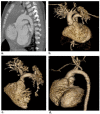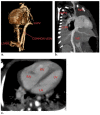Diagnostic Validity and Reliability of Low-Dose Prospective ECG-Triggering Cardiac CT in Preoperative Assessment of Complex Congenital Heart Diseases (CHDs)
- PMID: 36553346
- PMCID: PMC9776829
- DOI: 10.3390/children9121903
Diagnostic Validity and Reliability of Low-Dose Prospective ECG-Triggering Cardiac CT in Preoperative Assessment of Complex Congenital Heart Diseases (CHDs)
Abstract
For the precise preoperative evaluation of complex congenital heart diseases (CHDs) with reduced radiation dose exposure, we assessed the diagnostic validity and reliability of low-dose prospective ECG-gated cardiac CT (CCT). Forty-two individuals with complex CHDs who underwent preoperative CCT as part of a prospective study were included. Each CCT image was examined independently by two radiologists. The primary reference for assessing the diagnostic validity of the CCT was the post-operative data. Infants and neonates were the most common age group suffering from complex CHDs. The mean volume of the CT dose index was 1.44 ± 0.47 mGy, the mean value of the dose-length product was 14.13 ± 5.4 mGy*cm, and the mean value of the effective radiation dose was 0.58 ± 0.13 mSv. The sensitivity, specificity, PPV, NPV, and accuracy of the low-dose prospective ECG-gated CCT for identifying complex CHDs were 95.6%, 98%, 97%, 97%, and 97% for reader 1 and 92.6%, 97%, 95.5%, 95.1%, and 95.2% for reader 2, respectively. The overall inter-reader agreement for interpreting the cardiac CCTs was good (κ = 0.74). According to the results of our investigation, low-dose prospective ECG-gated CCT is a useful and trustworthy method for assessing coronary arteries and making a precise preoperative diagnosis of complex CHDs.
Keywords: cardiac CT; complex CHDs; low-dose; prospective ECG-gated.
Conflict of interest statement
The authors of this manuscript declare no relevant conflict of interest and no relationships with any companies whose products or services may be related to the subject matter of the article.
Figures



Similar articles
-
Diagnostic accuracy of sub-mSv prospective ECG-triggering cardiac CT in young infant with complex congenital heart disease.Int J Cardiovasc Imaging. 2016 Jun;32(6):991-8. doi: 10.1007/s10554-016-0854-8. Epub 2016 Feb 20. Int J Cardiovasc Imaging. 2016. PMID: 26897005
-
Prospective ECG-gated high-pitch dual-source cardiac CT angiography in the diagnosis of congenital cardiovascular abnormalities: Radiation dose and diagnostic efficacy in a pediatric population.Diagn Interv Imaging. 2016 Nov;97(11):1141-1150. doi: 10.1016/j.diii.2016.03.014. Epub 2016 May 4. Diagn Interv Imaging. 2016. PMID: 27156243
-
Radiation dose for thoracic and coronary step-and-shoot CT using a 128-slice dual-source machine in infants and small children with congenital heart disease.Pediatr Radiol. 2011 Feb;41(2):244-9. doi: 10.1007/s00247-010-1804-6. Epub 2010 Sep 4. Pediatr Radiol. 2011. PMID: 20821005
-
Evaluation of image quality and radiation dose at prospective ECG-triggered axial 256-slice multi-detector CT in infants with congenital heart disease.Pediatr Radiol. 2011 Jul;41(7):858-66. doi: 10.1007/s00247-011-2079-2. Epub 2011 May 2. Pediatr Radiol. 2011. PMID: 21534003
-
Coronary CT angiography with prospective ECG-triggering: an effective alternative to invasive coronary angiography.Cardiovasc Diagn Ther. 2012 Mar;2(1):28-37. doi: 10.3978/j.issn.2223-3652.2012.02.04. Cardiovasc Diagn Ther. 2012. PMID: 24282694 Free PMC article. Review.
References
-
- Huang M.-P., Liang C.-H., Zhao Z.-J., Liu H., Li J.-L., Zhang J.-E., Cui Y.-H., Yang L., Liu Q.-S., Ivanc T.B., et al. Evaluation of image quality and radiation dose at prospective ECG-triggered axial 256-slice multi-detector CT in infants with congenital heart disease. Pediatr. Radiol. 2011;41:858–866. doi: 10.1007/s00247-011-2079-2. - DOI - PubMed
Grants and funding
LinkOut - more resources
Full Text Sources

